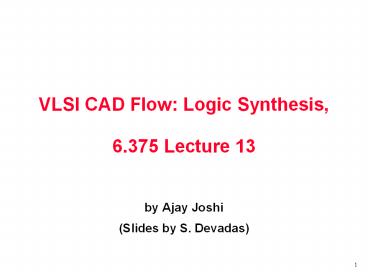VLSI CAD Flow: Logic Synthesis, 6.375 Lecture 13 - PowerPoint PPT Presentation
Title:
VLSI CAD Flow: Logic Synthesis, 6.375 Lecture 13
Description:
Gate count (fanout) reduction DELAY (Speed) ... For e.g. in algebraic substitution (or division) if a function f = f(a, b, c) is ... – PowerPoint PPT presentation
Number of Views:34
Avg rating:3.0/5.0
Title: VLSI CAD Flow: Logic Synthesis, 6.375 Lecture 13
1
VLSI CAD Flow Logic Synthesis, 6.375 Lecture 13
- by Ajay Joshi
- (Slides by S. Devadas)
2
RTL Design Flow
HDL
manual design
RTL Synthesis
netlist
logic optimization
netlist
physical design
layout
3
Logic optimization flow
LOGIC EQUATIONS
FactoringCommonality Extraction
TECHNOLOGY-INDEPENDENT OPTIMIZATION
TECH-DEPENDENT OPTIMIZATION (MAPPING,
TIMING)
LIBRARY
OPTIMIZED LOGIC NETWORK
4
Logic optimization flow
LOGIC EQUATIONS
FactoringCommonality Extraction
TECHNOLOGY-INDEPENDENT OPTIMIZATION
TECH-DEPENDENT OPTIMIZATION (MAPPING,
TIMING)
LIBRARY
OPTIMIZED LOGIC NETWORK
5
Why logic optimization?
- Transistor count redution AREA
- Circuit count redution POWER
- Gate count (fanout) reduction DELAY (Spee
d) - Area reduction, power reduction and delay
reduction improves design
6
Boolean Optimizations
InvolvesFinding common subexpressions.Substitut
ing one expression into another.Factoring single
functions.
- Find common expressions
- Extract and substitute common expression
f1
AB
AC
AD
AE
A
B
C
D
E
ì
F
í
î
f2
A
B
A
C
A
D
A
F
A
B
C
D
F
f1
A
B
C
D
E
(
)
A
B
C
D
E
ì
F
í
f2
A
B
C
D
F
(
)
A
B
C
D
F
î
g1
B
C
D
ì
í
G
f1
A
g1
E
(
)
A
E
g1
ï
î
f2
A
g1
F
(
)
A
F
g1
7
Algebraic Optimizations
- Algebraic techniques view equations as
polynomials - Rules of polynomial algebra are used
- For e.g. in algebraic substitution (or division)
if a function f f(a, b, c) is divided by g
g(a, b), a and b will not appear in f / g - Boolean algebra rules are not applied
8
Logic optimization flow
LOGIC EQUATIONS
FactoringCommonality Extraction
TECHNOLOGY-INDEPENDENT OPTIMIZATION
TECH-DEPENDENT OPTIMIZATION (MAPPING,
TIMING)
LIBRARY
OPTIMIZED LOGIC NETWORK
9
Closed Book Technologies
- A standard cell technology or library is
typically restricted to a few tens of gatese.g.,
MSU library 31 cells - Gates may be NAND, NOR, NOT, AOIs.
B
A
A
C
A
A
ABC
A
C
B
10
Standard cell library
- For each cell
- Functional information
- Timing information
- Input slew
- Intrinsic delay
- Output capacitance
- Physical footprint
- Power characteristics
11
Sample Library
INVERTER 2
NAND2 3
NAND3 4
NAND4 5
12
Sample Library - 2
AOI21 4
AOI22 5
13
Mapping via DAG Covering
- Represent network in canonical form Þ subject
DAG - Represent each library gate with canonical forms
for the logic function Þ primitive DAGs - Each primitive DAG has a cost
- Goal Find a minimum cost covering of the
subject DAG by the primitive DAGs
Directed Acyclic Graph
14
Trivial Covering
Reduce netlist into ND2 gates ? subject DAG
7 NAND2 21 5 INV 10
31 (area cost)
15
Covering 1
2 INV 4 2 NAND2 6 1 NAND3 4 1 NAND4 5
19 (area cost)
16
Covering 2
1 INV 2 1 NAND2 3 2 NAND3 8 1 AOI21 4
17 (area cost)
17
Multiple fan-out
18
Partitioning a Graph
- Partition input netlist into a forest of trees
- Solve each tree optimally
- Stitch trees back together
19
Optimum Tree Covering
INV 11 2 13
AOI21 4 3 7
NAND2 2 6 3 11
NAND2 3 3 6
INV 2
NAND2 3
NAND2 3
20
DAG Covering steps
- Partition DAG into a forest of trees
- Normalize the netlist
- Optimally cover each tree
- Generate all candidate matches
- Find optimal match using dynamic programming
21
Summary
- Logic optimization is an important step in the
design flow - Two-step flow
- Technology independent optimization
- Technology dependent optimization
- Advantages of logic optimization
- Reduce area
- Reduce power
- Reduce delay
22
For more details
- Refer to Srinivas Devadas slides for 6.373
http//csg.csail.mit.edu/u/d/devadas/public_html/6
.373/lectures/































